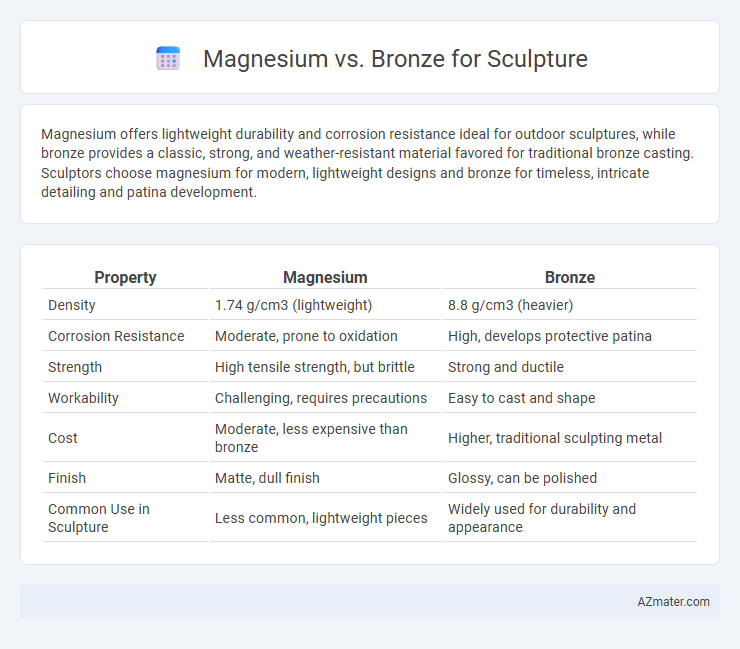Magnesium offers lightweight durability and corrosion resistance ideal for outdoor sculptures, while bronze provides a classic, strong, and weather-resistant material favored for traditional bronze casting. Sculptors choose magnesium for modern, lightweight designs and bronze for timeless, intricate detailing and patina development.
Table of Comparison
| Property | Magnesium | Bronze |
|---|---|---|
| Density | 1.74 g/cm3 (lightweight) | 8.8 g/cm3 (heavier) |
| Corrosion Resistance | Moderate, prone to oxidation | High, develops protective patina |
| Strength | High tensile strength, but brittle | Strong and ductile |
| Workability | Challenging, requires precautions | Easy to cast and shape |
| Cost | Moderate, less expensive than bronze | Higher, traditional sculpting metal |
| Finish | Matte, dull finish | Glossy, can be polished |
| Common Use in Sculpture | Less common, lightweight pieces | Widely used for durability and appearance |
Introduction to Sculpture Materials
Magnesium and bronze serve distinct roles in sculpture materials, with bronze being a traditional alloy composed primarily of copper and tin, renowned for its durability and classic aesthetic appeal in art. Magnesium, a lightweight and corrosion-resistant metal, offers innovative possibilities for sculptors seeking modern materials with unique structural properties. The choice between magnesium and bronze depends on factors like desired texture, weight, and environmental exposure, influencing the longevity and visual impact of the sculpture.
Historical Use of Magnesium and Bronze in Art
Bronze has been a preferred material for sculpture since ancient times, especially in classical civilizations like Greece and Rome, due to its durability, workability, and aesthetic appeal. Magnesium, although commonly used in modern industrial applications, found limited historical use in art because of its reactivity and challenges in casting compared to bronze's proven longevity. Today, bronze remains a symbol of classical sculpture, while magnesium's lightweight properties are explored mainly in contemporary and experimental art forms.
Physical Properties: Magnesium vs Bronze
Magnesium offers a lightweight alternative with a density of approximately 1.74 g/cm3 compared to bronze's higher density around 8.7-8.9 g/cm3, making magnesium sculptures easier to handle and transport. Bronze exhibits superior hardness and tensile strength, generally between 370-560 MPa, which enhances durability and resistance to deformation, whereas magnesium's tensile strength is lower, typically around 160-300 MPa. Corrosion resistance varies, with bronze demonstrating better natural resistance due to its copper content, while magnesium requires protective coatings to prevent oxidation and weathering in outdoor installations.
Aesthetic Qualities and Visual Appeal
Magnesium sculptures exhibit a modern, sleek aesthetic with a silvery-white metallic sheen that highlights fine details and creates a contemporary visual impact. Bronze, known for its warm, rich tones and natural patina development, offers a timeless, classical appeal that enhances depth and texture over time. The choice between magnesium and bronze depends on desired visual effects: magnesium provides a bright, industrial look while bronze delivers a traditional, earthy warmth.
Durability and Weather Resistance
Magnesium offers lightweight properties but is more prone to corrosion and requires protective coatings for outdoor sculptures. Bronze, an alloy of copper and tin, exhibits superior durability and natural weather resistance, developing a protective patina over time that prevents rust and degradation. Sculptors prioritize bronze for outdoor installations due to its long-lasting strength and ability to withstand harsh environmental conditions.
Workability and Sculpting Techniques
Magnesium offers superior workability for sculptors due to its light weight and excellent malleability, enabling intricate detailing with less physical effort compared to bronze. Bronze, known for its hardness and durability, requires higher temperatures and more advanced casting techniques, which can be challenging but results in a long-lasting, patina-rich finish. Both metals respond well to traditional sculpting methods, but magnesium favors rapid prototyping and fine detail work, while bronze excels in enduring outdoor installations.
Cost and Availability Comparison
Magnesium offers lower material costs due to its abundance and lighter weight, reducing transportation and handling expenses in sculpture production compared to bronze. Bronze, an alloy of copper and tin, generally incurs higher raw material and casting costs due to its density and smelting complexity. Availability-wise, bronze remains widely accessible through established foundries worldwide, while magnesium requires specialized facilities due to its reactivity and flammability during casting.
Environmental Impact and Sustainability
Magnesium offers a lower environmental impact than bronze due to its abundance and lower energy consumption during extraction and processing. Bronze production involves copper and tin mining, which can lead to significant habitat disruption and higher carbon emissions. Magnesium's recyclability and lighter weight contribute to enhanced sustainability in sculpture manufacturing compared to traditional bronze sculptures.
Case Studies: Notable Sculptures in Magnesium and Bronze
The Angel of the North in England exemplifies bronze's durability and patina that enhance outdoor sculptures over time, while the innovative Magnesium Alloy Sculpture by artist Olafur Eliasson demonstrates magnesium's lightweight advantages and modern aesthetic potential. Bronze sculptures like Auguste Rodin's The Thinker showcase classical strength and fine detail preservation, whereas magnesium sculptures are increasingly explored in contemporary art for their corrosion resistance and ease of casting. These case studies highlight bronze's historical prominence and magnesium's emerging role in experimental and large-scale sculptural works.
Choosing the Right Material for Your Sculpture Project
Magnesium offers lightweight properties and excellent machinability, making it ideal for intricate or large-scale sculptures that require ease of handling. Bronze provides superior durability, corrosion resistance, and a timeless aesthetic, favored for outdoor and traditional sculptures that demand longevity. Selecting between magnesium and bronze depends on your project's requirements for weight, finish, environmental exposure, and budget constraints.

Infographic: Magnesium vs Bronze for Sculpture
 azmater.com
azmater.com